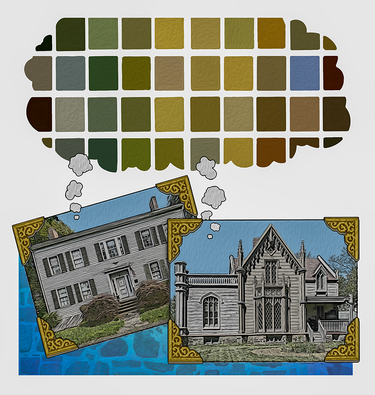Imagine the palette of our past highlighting our town’s historic homes
Two of Guilderland’s town-owned houses — both on the National Register of Historic Places — will soon have new paint.
We commend the town board for its unanimous vote to spend the funds to paint the houses, a necessary act of preservation.
Over too many years, the paint has faded, peeled, and chipped on both of the historic structures. Proper painting not only makes old buildings look good, it is essential to make them last for future generations.
Supervisor Peter Barber, a strong supporter of saving historic buildings in town, noted that the money for painting the Mynderse-Frederick House came from a grant but credited Colin J. Gallup, the town’s director of Parks and Recreation, for “saving money, putting money in reserves” to pay for painting the Schoolcraft House.
“It’s rather expensive, $142,000 to paint two buildings,” said Barber.
We, too, commend Gallup both for setting aside the funds to paint and for persevering in the restoration of the Schoolcraft House. It is money well spent. The town did this responsibly, getting bids for the work.
In round numbers, WS Carpentry is painting the Mynderse-Frederick House for $63,000, and the Schoolcraft House for $79,000 — a total of $142,000.
The two other bids were: $235,000 from NuVista Designs, and $235,725 from Above and Beyond Carpentry.
“They’ll bring a lot of charm and beauty to the town,” said Councilwoman Christine Napierski.
She is right. They will also give us a sense of Guilderland’s history. Old buildings tell unique stories, distinguishing a place by highlighting its past distinct from the modern-day homes and places of business that often look much the same anywhere.
“They should be used,” said Councilwoman Rosemary Centi.
The Guilderland Garden Club and the Guilderland Historical Society both meet in the Mynderse-Frederick House. But we agree more uses should be found for both venues. There was talk of library events being held at the Schoolcraft House, and perhaps the Guilderland Chamber’s current Four Seasons initiative could encourage further uses.
“They’re beautiful,” said Centi, who is retiring at the end of her term in December. She thanked Barber “for moving this along” and added, “I would like to see it painted before I leave.”
“We’ll give you a golden paintbrush,” said Councilwoman Amanda Beedle.
Barber said he hoped the buildings could be painted before the cold weather sets in. “Just don’t ask me the color,” he said.
Color is important, giving the viewer — whether a casual passer-by or a resident deeply interested in the town’s history — visual cues to a building’s past.
Long before “whitewash” became a verb meaning to gloss something over or cover something up, it had its roots in a substance, lime paint.
Since Colonial times, Americans whitewashed their buildings inside and out. Lime repelled insects and killed bacteria.
It was inexpensive to make and easy to apply — even a kid could do it, as Mark Twain made famous with his character Tom Sawyer having to whitewash Aunt Polly’s fence on a beautiful summer day. Tom, of course, turns it around so that his friends covet the job and do it for him.
“He had discovered a great law of human action,” writes Twain, “without knowing it — namely, that in order to make a man or a boy covet a thing, it is only necessary to make the thing difficult to attain.”
So fences and sheds, barns and hen houses were whitewashed throughout America — but houses, at the time the two town-owned homes in Guilderland were built, generally were not white.
Although it much later became the fashion to think of old houses as being white, often with green shutters, this is not how most were actually colored at the time they were built.
Guilderland’s two soon-to-be painted historic houses were built less than a half-century apart, but they served very different purposes and were built in very different styles. Their new coats of paint should reflect that.
The Mynderse-Frederick House, a center-hall Colonial on Schoharie Road, now Route 146 in Guilderland Center, was built in 1802 by Nicholas V. Mynderse. He ran a tavern there and was elected as Guilderland’s first supervisor.
Mynderse sold the 15-room Federal-style house to Michael Frederick, and three generations of the Frederick family ran a tavern and inn there until it became their private home. Stephen Frederick was also elected a Guilderland supervisor.
The house was last painted in 2002 by Bob Ertelt who scraped the clapboards down to their bare wood and discovered the original paint color was brown — made from the sand or dirt in area fields, mixed with water, typical of the late 1700s and early 1800s.
“Only rarely does a historic paint scheme of the desired period of restoration remain intact; a more typical situation involves the need to discover and replicate an original finish which may be hidden under many later layers of paint,” says a guide put out by the United States Department of the Interior, “Painting Historic Buildings: Materials and Techniques.”
In the case of the Mynderse-Frederick House, Ertelt’s careful work has already uncovered the original color without need of the microscopic evaluations detailed in the guide.
Houses of this style in this era, with paints from naturally-derived pigments, often had the body and trim in the same color with the shutters and doors in a darker color or black.
Certainly WS Carpentry wouldn’t be expected to mix paints from naturally-derived pigments but fortunately several high-quality commercial paint companies have historic color palettes from which to choose.
As the Department of the Interior guide urges, “Moreover, the preservationist must ensure that paint endures sufficiently well to serve its protective function, an especially difficult challenge on exterior surfaces which are constantly exposed to weathering.”
While the Mynderse-Frederick home was built as a working inn and tavern, as well as a family home, accommodating travelers and their horses on the busy Schoharie Plank Road, the Schoolcraft House was built in the 1840s on Guilderland’s Western Turnpike, now busy Route 20, as a summer retreat.
Congressman John L. Schoolcraft, one of the original presidents of the Albany bank now known as KeyBank, built the Gothic Revival home then known as a “cottage” but later called a “mansion.”
Andrew Jackson Downing, considered the father of American landscape architecture, was the central proponent of the Gothic Revival movement.
He published a book in 1842, “Cottage Residences; or A Series of Designs for Rural Cottages and Cottage Villas, and their Gardens and Grounds Adapted to North America,” with patterns for cottages that look very much like the Schoolcraft House, blending the pastoral Picturesque aesthetic from the English countryside with romantic architecture.
Downing also popularized the front porch on American homes, seeing it as a link to nature with its healing powers. For wealthy Americans in the mid-19th Century, the ultimate status symbol was a country retreat, like Schoolcraft’s in then-rural Guilderland.
“The sylvan and floral collections … which surround the country residence of a man of taste,” wrote Downing in his 1841 “Treatise on the Theory and Practice of Landscape Gardening,” are confined only by “the blue heaven above and around them.”
In his influential “Cottage Residences,” Downing provided six color swatches in keeping with the ideals of the Picturesque movement, reflecting the subtle colors of nature rather than the strident white used on Greek Revival homes.
“No painter of landscapes that has possessed a name was ever guilty of displaying in his pictures a glaring white house, but, on the contrary, the buildings introduced by the great masters have uniformly a mellow softened shade of color, in exquisite keeping with the surrounding objects,” Downing wrote.
He called for neutral colors, including gray, brown, fawn and what he called “drab” — all the colors of natural materials such as sand, earth, clay, straw, slate, and stone.
Gothic Revival buildings were generally painted with three different colors: one for the body of the house, a second for the trim, and a third for the doors and shutters.
The late Alice Begley’s signature project as Guilderland’s town historian was the restoration of the Schoolcraft House. “Every town needs a few symbols to remind them of what was,” Begley said as she undertook the project.
“That house is so incredibly beautiful, and it was devastated,” Begley said of the Schoolcraft House when she retired in 2016. “When the town purchased it, an upstairs bedroom ceiling had collapsed to the room below. The church next door wanted to buy it to use for a parking lot.”
Begley also wrote a book, detailing Schoolcraft’s life and his house. “If the house is worth restoring, the man who built it is worth writing about,” she said.
The Schoolcraft House is now brown, a color chosen by Begley, who led a drive in which people donated cans of paint to make the siding more historically accurate than the former white.
We hope, in choosing the paint colors for the Schoolcraft House, Downing’s book is consulted and the magnificent trim is highlighted in a color different from the body of the house.
So much careful work has gone into its restoration, the Schoolcraft House deserves to be shown off with appropriate colors.
After all, choosing historically accurate colors will cost no more than using the ubiquitous white that once obscured the history of these homes.
If, as Mark Twain wrote, a great law of human action is, when something is difficult to attain, we will covet it, let us think of researching original paint colors as a challenge that will have us coveting our past.


